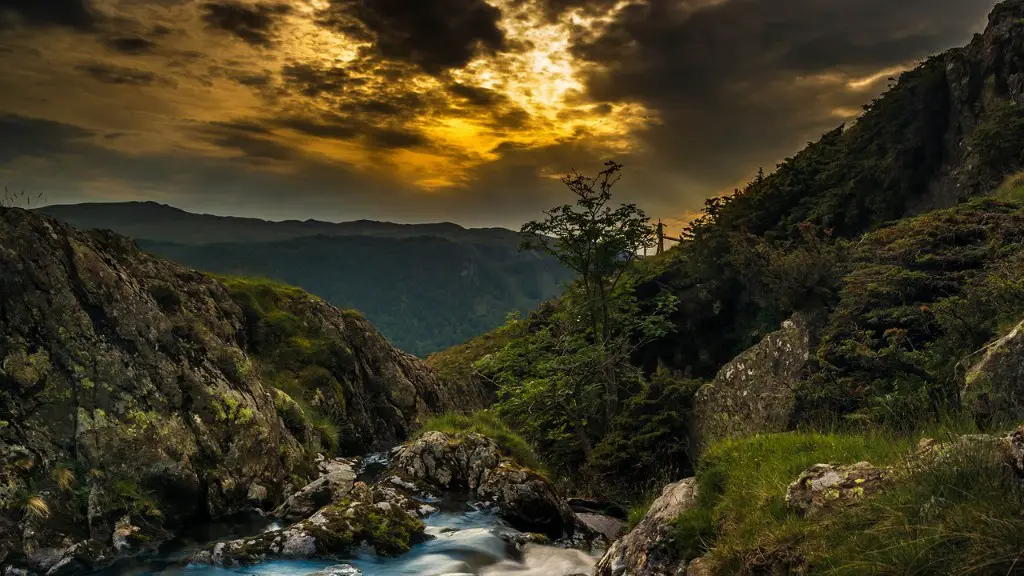The Mississippi River is a vital part of American life, and its meandering course has been shaped by both human and natural forces. From its headwaters in Lake Itasca in northern Minnesota to its delta in the Gulf of Mexico, the Mississippi is the fourth-longest river in the world. For thousands of years, the area around the Mississippi River has hosted myriad cultures—many of whom have left their mark on the landscape. Today’s Mississippi River is drastically different than it was centuries ago, and it has been altered by human interference.
The deep, fast-flowing streams throughout the river have been tempered by dams, levees, locks and floodways, which help to prevent flooding, generate energy and aid navigation. The U.S. Army Corps of Engineers is a main source for the Mississippi’s modern-day engineering, wielding control of locks and dams that control water levels. As a result, the banks and tributaries of the river resemble lush green forests, marshlands or farmland, with many species of birds, fish, mammals and reptiles making their home along its edges.
In addition to these natural beauties, the Mississippi River has long been lined with travelers and traders from the 16th century onwards. Many of the ports between the gulf and the Great Lakes have grown into bustling cities, with agriculture and industry taking the form of railroads, roads, bridges and channels for shipping. Farming, fishing and timber harvest have also played a role in the river’s life, with the result being a diverse ecosystem that is constantly changing. The Mississippi River also hosts a variety of cultural products including music, art, dance and literature that have been uniquely shaped by the river’s influence.
Today’s Mississippi has been dramatically changed by human influence and is facing greater challenges than ever before. Army corps engineers are not only having to manage the river’s resources, they are now tasked with battling against the effects of global warming such as retreating glaciers, rising sea levels and extreme weather events. Pollution and runoff are greatest threats to the river’s health, resulting in dead zones, water contamination and habitat destruction. All of these combine to make managing the river and its resources even more challenging.
The environmental impact of human activity as well as the introduction of invasive species have also had an effect on the river, with dramatic shifts occurring in its ecosystems. Non-native species such as Asian carp, zebra mussels and nutria have taken over, disrupting the natural order and threatening the survival of native species and the food chain itself. In addition, the silting of the river from agricultural activities and development have caused the narrowing of its channels, making the river difficult to navigate.
The Mississippi River’s changing landscapes tell a story of resilience, adaptation and survival. As humans continue to modify and manage the river’s resources, it is essential for all of us to understand the importance of our relationship to the river and the need for conservation and restoration initiatives to maintain its health.
Effects on Local Communities
The Mississippi River has long served as a transportation outlet for local communities and continues to do so today. Fishermen, hunters and trappers travel the river in hopes of finding new resources to bring back home. Along the way, they come into contact with settlers, historians and officials that help maintain and support the river as it flows south. This has been a key way of life among these communities and different cultures in the river valley since Ancient times.
The Mississippi Valley has been a major factor in the history of the American South, contributing to its agricultural legacy. Many of the plantations along the Mississippi share a strong liquid attachment, relying on the river’s bounty for its production of cotton, indigo, corn and other crops. The river also helped to solidify trade relationships between different parts of the South, creating a unique link to the national economy.
Today, the Mississippi River is a major source of employment and support for people in the area. It provides economic revenue from its hotels, restaurants and recreational activities including fishing, camping, boating and more. In addition, it is an integral part of many communities’ futures, providing momentum for new development, infrastructure and innovation.
The Mississippi River is not only a source of livelihood, it is an inspiration. Those who reside along its banks frequently revel in its beauty, sharing stories of its mysteries and offering perspectives on its history. It is a place of refuge, a place to be embraced and respected.
Relationship With Local Ecosystems
The Mississippi River is home to a wide range of habitats, with diverse plant and animal life that depends upon its abundant resources. At the lower end of the river, the brackish waters form an estuary where fresh and saltwater mix, supporting a variety of species and attracting migrating birds, fish and shellfish.
Upstream, a series of wetlands, woods and minerals support amphibians, mammals and reptiles. All of this thrives in concert with the aquatic ecosystem, which includes more than 3,500 species of fish and macroinvertebrates. The river also links to an expansive coastal wetland, and its nutrient-rich runoff provides food for many animals, attracting large flocks of migratory birds.
The Mississippi River provides a vital corridor for sturgeon, threatened walleye and delicate mussel species. Its vast wetlands and floodplains counteract floods, filter toxins and provide food and shelter. Lastly, it links with tributaries and off-channel habitats leading to downstream nurseries and spawning grounds for native aquatic organisms making this region a critical repository of water and energy.
The river has served as a habitat to the rich and diverse life of the region for countless years. Conservation of the many species that call the Mississippi River home is essential to protect its natural beauty and to keep it healthy and sustainable for all kinds of life.
Immediate Challenges
There are impacts of climate change and human activity that must be addressed if the Mississippi River is to remain as a healthy as possible and continue to provide sustenance to the species that reside there. The river’s complex systems face considerable disruption from reduced water flow, nutrient runoff, and extreme storms or weather. These issues threaten to disrupt or reduce the species populations, food webs and ecosystem health.
In addition, the river and its tributaries have become increasingly clogged with trash, debris and sediment causing further disruption for the aquatic organisms that live there. Pollution, chemical runoff and fertilizer waste are also contributing factors. As population growth along the river continues, sewage and oil spills become more frequent, posing significant risks to aquatic organisms, human health and the quality of the water.
The Mississippi’s extensive watershed and its connected nature require increased attention and greater efforts to protect it from degradation. Conservation initiatives, water quality regulations and public education will all be essential steps to ensure a successful recovery of the river’s ecosystems and inhabitants.
Prevention of Future Damage
The Mississippi River needs to be managed and its waters must be taken care of if it is to remain a healthy waterway. Comprehensive plans must be made to mitigate global warming effects, pollution, debris and the introduction of invasive species. In addition, key habitats need to be preserved in order to protect the fragile ecosystems that exist there.
In recent years, an array of partnerships between public, private and non-profit organizations have been promoting land conservation, pollution prevention and water management strategies to ensure the long-term sustainability of the Mississippi River. Strategies such as floodplain restoration, riparian tree planting and wetland restoration can help to improve habitat conditions, water quality and reduce pollution.
In addition, the implementation of green infrastructure projects such as green roofs, soil conservation and rain gardens provide greater stormwater management by absorbing runoff, reduce erosion and promote carbon uptake. These strategies are key for the preservation of the Mississippi’s ecosystems and the hundreds of species that rely upon them daily.
Restoration of the River
Restoring the Mississippi River go beyond making sure it is clean and “safe” for human and animal life. It also entails repairing its ecosystem, restoring its shorelines, cleaning up its water and restoring its wetlands. All of these efforts must be undertaken in order to protect the river and its tributaries, and to ensure that future generations are able to enjoy it in its natural state.
Various conservation organizations and public agencies have implemented many successful restoration projects that help to balance the river’s natural systems with human activity. This includes planting native grasses, restoring wetlands and meadows, controlling erosion, and establishing buffers. The restoration of key habitats is essential to keep the Mississippi River healthy in the long term.
Furthermore, regional and federal partnerships have been set up in order to combine forces in the ongoing efforts to manage, protect and restore the Mississippi River. Through these initiatives and continual monitoring of the river’s condition, the health of the natural resources that make it a unique environment can be preserved and its beauty will endure.





